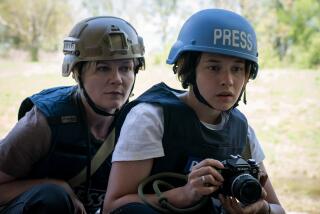Grasping a war told in real time
It says something about the novel situation in which the news media now find themselves that some of the most sensible observations about coverage of this war made over the last 24 hours came from Defense Department briefers.
In Qatar on Tuesday morning, Air Force Maj. Gen. Victor E. Renuart was asked by a New York Magazine writer how he assessed the media’s performance so far? On the whole, Renuart said, the reporting had been both fair and good, but he cautioned no single report -- or, for that matter, any single day’s reporting -- should be taken as more than a “snapshot” of the war in progress.
At the Pentagon a couple of hours later, Secretary of Defense Donald Rumsfeld called the reports and images filed live by journalists embedded in combat units “a breathtaking sight.” But what they should not be expected to provide, he added, is “the overall context” for a conflict moving so fast that even Rumsfeld found himself fumbling to recall that the air campaign had begun in earnest just five days ago.
Perhaps we will look back on this conflict’s early days and conclude that the second Gulf War’s first casualty was not truth, but understanding. Facts -- or at least events -- are everywhere. Persuasive accounts of their significance are in shorter supply.
The West’s major newspapers, by and large, are doing a better-than-credible job of assembling Renuart’s snapshots into a 24-hour montage of the day’s events. As the fighting continues, perspective proceeds from experience. Tuesday, for example, leading papers -- including the Los Angeles Times and New York Times -- published front page news analyses wondering whether Rumsfeld’s infatuation with high-tech weaponry and unconventional warfare had lead Pentagon planners to put too few regular troops on the ground. (In fact, that anxiety was first expressed Sunday by one of CNN’s expert military commentators, former NATO commander Wesley Clark.)
The point is that, just as the daily face of war changes, so does the tone of the coverage around the world. And one of the benefits of new media -- particularly the Web and satellite broadcasting -- is that they are allowing readers and viewers to see this first-hand.
At the fighting’s outset, for example, the U.S. media seemed excessively enthralled over its new access to the military, and overly deferential to the administration’s view of events. The British media, by contrast, were skeptical, almost bitterly so. Over the last few days, however, the coverage has converged in many important respects.
While U.S. papers now are willing to cast a critical eye on the Pentagon’s strategic thinking, Britian’s print press is taking cognizance of new facts. Tuesday’s lead story in the impeccably left-wing Guardian, for instance, was headlined “Support for War Surges.” The story reported that “the 15-point swing in public opinion ... means there is now a clear majority, 54% who back military action after a sharp rise from 38% just a week ago. The results represent a sudden and widespread shift in public mood in Britain.” Commentators in the Guardian and elsewhere in the British press speculated that at least some of the swing was a consequence of reports from the Gulf stressing the steps being taken by the coalition to avoid civilian casualties.
Readers who want to work toward understanding by assembling their own collage of journalism from the war can read all the better British newspapers on the Web. The Guardian, for example, is available at www.guardian.co.uk. Sir John Keegan, the most distinguished military historian writing in the English language, is the conservative Telegraph’s defense editor. Monday, that paper’s Web site featured his analysis of the current tactical situation with particular emphasis on the overlooked importance of the coalition’s seizure of the Euphrates River bridges and the unprecedented rapidity of the armored advance. His analysis can be found at www.telegraph.co.uk.
Some things, of course, don’t change.
In the U.S., Fox News simply has wrapped itself in the flag and makes no effort to distinguish between its journalism and the U.S. war effort. Fox executives can be pleased that their approach has allowed the network to hold the lead in cable news ratings; the rest of us can be relieved that viewers who want that sort of thing will be too busy having their prejudices confirmed to bother the rest of us. With some notable exceptions, meanwhile, the British Broadcasting Corp. -- heard nightly on many PBS and NPR stations -- has continued to elevate traditional reportorial skepticism to near-toxic levels.
Former New Republic editor Andrew Sullivan, who has used his pro-war Web site, www.andrewsullivan.com, to document many of the BBC’s excesses, refers to the Beeb, as it’s called, as “the Baghdad Broadcasting Corp.” (More checks and balances in the new media.)
“The irony of the BBC right now,” the British-born Sullivan said, “is that they have long been tarred in Britain as too pro-Tony Blair. They have been called the ‘Blair Broadcasting Corp.’ The way they have shown their independence is by attacking Blair from the left, which explains part of the fervent anti-Americanism.”
Some things have changed utterly; above all the pace at which we’re being asked to make sense of the facts.
Peter Osnos, now publisher and chief executive of Public- Affairs Press, was in Vietnam precisely 30 years ago, at the end of a three-year assignment as a correspondent for the Washington Post. Today, his son Evan is a Chicago Tribune reporter embedded with the 1st Marine Division. “In Vietnam,” the elder Osnos recently recalled, “a major operation would begin somewhere up country, and we would scramble to get there and watch what was going on. Then, we’d have to find a way to transport ourselves back to some filing point, which could take half a day or more. It took 48 hours to get film from Saigon to Hong Kong and from there to New York. If I filed a story at 10 p.m. local time, my readers in Washington read it 24 hours later.”
Yet that era’s combat correspondence -- delivered at what now seems a snail’s pace -- helped change a nation’s mind about what was happening and what was at stake in Southeast Asia.
“It’s all different now,” Osnos said, “all in real time. My son and the other embedded reporters in the 1st Marine Division are sitting somewhere on the frontline, chem suits pulled over their heads, writing stories on laptops that they’ll file to their papers’ Web sites over satellite phones. For the moment, we’re all transfixed.”
And, as we’re all beginning to learn, transfixed is different from informed.
More to Read
Sign up for Essential California
The most important California stories and recommendations in your inbox every morning.
You may occasionally receive promotional content from the Los Angeles Times.










